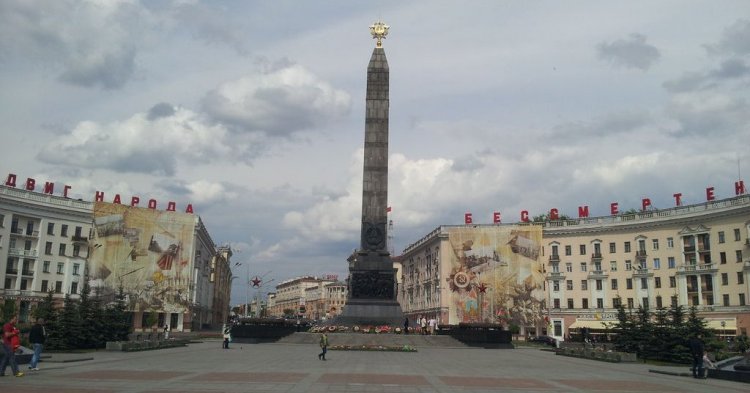On November 17th 2019, Belarus held parliamentary elections. Although it was due to take place in 2020, President Lukashenko decided to bring the date forward. The results showed that Lukashenko, who has been in charge of the country since 1994, maintained his strong hold on the House of Representatives.
Indeed, each of the 110 representatives support the government. According to the official results, 89 seats were won by pro-Lukashenko independent candidates, 11 seats by the Communist Party of Belarus (CPB), 6 seats by the Republican Party of Labour and Justice (RPLJ), 2 seats by the Belarussian Patriotic Party (BPP) and 1 seat each by the Liberal Democratic Party (LDP) and the Belarussian Agrarian Party. All these parties are pro-government, and although the LDP declares itself to be a “constructive democratic opposition”, it is de facto pro-government.
Unlike 2016, no opposition party was allowed to take part in the election. Three years ago, two members of the opposition were elected (Hanna Konopatskaya of the United Civic Party and the independent Alena Anisim).
The 110 members of the House of Representatives were previously elected using the two-round system. However, a new electoral code was introduced in 2013, abolishing the requirement for candidates to receive an absolute majority, thus creating a first-past-the-post election system. That means that neither the two-round nor the first-past-the-post systems take into account the actual proportionality of the vote: in 2016, both the Belarussian Patriotic Party (BPP) and the United Civic Party (UCP) gained around 111,000 votes, but the former won three constituency seats and the latter only one.
At first glance, the EU’s reaction to the Belarussian election appears to have been clear: Brussels and the OSCE regretted a “missed opportunity” and the “lack of respect of democratic rules”, whereas Moscow welcomed a “traditional high degree of organization”. However, it is uncertain whether the EU would re-introduce sanctions against Belarus, having previously lifted them in 2016. Lukashenko’s country is located at the heart of Europe, where Russia and the European Union meet. It therefore has strategic importance both for Moscow and Brussels.
Towards a possible fusion between Russia and Belarus?
Like the rest of the former Soviet republics, Belarus gained its independence from the collapse of the USSR in 1990-1991. However, unlike its Baltic neighbours (Estonia, Latvia and Lithuania), the country had never been independent in the past—except during the very short Belarussian People’s Republic—and therefore lacked any state tradition. The first government, elected in August 1991, was led by Stanislav Shushkevich and tried to create closer ties with Western Europe. However, he was overthrown in 1994 by the mainly pro-Russian House of Representatives and was replaced by Alexander Lukashenko.
Lukashenko had had a long career in the administration of the Byelorussian Soviet Socialist Republic and was known for his loyalty towards the Soviet Union. He was even the only Belarussian Representative who opposed the dissolution of the USSR in December 1991. He sought closer ties with the Russian Federation, while nevertheless keeping his country independent.
In 1997, Alexander Lukashenko and Boris Yeltsin launched negotiations to set up a supranational union (the “Union State of Russia and Belarus”), leading to an ever-closer union between Moscow and Minsk in the fields of monetary and fiscal policy, energy, and even constitutional affairs. The ultimate goal was a fusion between the two countries.
Although two treaties were signed in 1997 and 1999, officially setting up the Union State, this never led to concrete results, as the divergences between Russia and Belarus became obvious. Lukashenko demanded to be the President of this new supranational union.
After years of frozen negotiations, the Russian Prime Minister Dmitry Medvedev suggested a relaunch of talks in 2018. Much of the political dimension of the Union was abandoned and focused instead on a deep economic union. The reason for this change can be traced back to the result of a 1995 referendum, which showed that the Belarussian people desired more cooperation with Russia, but only on the economic front. Russia and Belarus have already started harmonizing some policies: qualifications are mutually recognized, and freedom of movement has been achieved. However, Alexander Lukashenko recently warned Russia not to force Belarus into a union. On December 8th, a demonstration, tolerated by the government, even took place in Minsk to oppose the project of the supranational union.
Russia’s very political interest in Belarus
For Minsk, the interest in a supranational union is mainly economic: Belarus is strongly dependent on Russia’s economy, especially concerning its energy supply. Such a move would mean even cheaper gas and oil prices. Belarus already benefits from preferential tariffs, as the country paid 146 dollars for 1000 cubic liters of natural gas in 2017 (whereas the rest of Russia’s partners had to pay 179 dollars). Regardless, Russian regions paid half as much as Belarus. For Moscow, however, the Union State would have a more political meaning. Russia wants to be sure of Belarus’ loyalty, as several other former Soviet Republics, such as Ukraine and Georgia, have chosen a pro-Western diplomatic strategy —to say nothing of the Baltic states, who joined the EU as early as 2004.
The Union State is not the only attempt of Moscow to regain influence over the newly independent states of the collapsed Soviet Union. Russia, Ukraine and Belarus founded the Commonwealth of Independent States in 1991, which consisted of ten former Soviet republics before Ukraine withdrew in 2018. More recently, the Eurasian Economic Union was founded in 2014 by Russia, Belarus and Kazakhstan. This Union is considered a rival to the EU.
Belarus – EU relations: “it’s complicated”
By the way, what is the current state of EU-Belarus relations? While Minsk and Brussels have had strained relations since Lukashenko’s accession to the presidency, periods of détente have occurred. In 1997, the EU imposed economic sanctions on the increasingly authoritarian President. The situation got better between 2008 and 2010, during a conflict over gas with Russia, but deteriorated once again in 2010, when Lukashenko cracked down on opposition movements after the biased presidential elections.
More recently, the war between Russia and Ukraine and the illegal annexation of Crimea provided an opportunity for Belarus to be an arbitrator between Moscow, Kiev and Brussels. The Minsk Protocol was signed in September 2014, and showed that Belarus wishes to be a reliable partner and intermediary with Putin’s Russia. In 2015, the EU’s economic sanctions and visa restrictions were suspended; then, in 2016, they were nearly abolished.
Belarus is part of the Eastern Partnership, the EU’s political and economic initiative to create closer links with the Eastern European and South Caucasus countries, including Ukraine, Moldova, Georgia, Armenia and Azerbaijan. Bilateral relations remain very restricted, however, and an improvement is conditional on the respect of human rights in Belarus, which is not the case despite the lifting of sanctions.
Can Belarus join the European Union?
At first glance, this question looks a bit provocative, but it might not be so silly. President Lukashenko has been trying to find a balance in his relations with the EU and Russia. Furthermore, defiance towards Moscow seems to increase as Russia puts pressure on its tiny neighbour to complete the Union State. Some pundits say that this Union is the only way for Vladimir Putin to remain in power after 2024 without changing the Russian constitution.
Relations with the EU therefore appear to be political leverage for Minsk: the better these relations are, the more scope for for negotiation for Minsk. So, although the country is much more integrated with Russia than the EU, perhaps Belarus can join the European Union in the future? At first sight, the answer is clearly no: Belarus’ economy is fundamentally incompatible with the EU’s, the death penalty is still used, and very deep ties with Russia are hindering the development of closer ties with the EU.
A bridge between the EU and Russia?
Even if the country run by Alexander Lukashenko is very unlikely to join the EU in the near future, can it be a sustainable and efficient bridge between the EU and Russia in multiple domains, such as the economy and energy? This is Lukashenko’s dream; but Russia’s push towards increasing integration could jeopardize the very independence of Belarus. Could a rapprochement with the EU be a more sustainable path for development? This would require a deep democratization of the regime, and perhaps a change of economic model—two alterations that Lukashenko and the Belarussian establishment are not at all ready to implement.


Follow the comments: |
|
